When choosing outdoor bonsai styles, think about the vibe you want to create. Each style, like the S-shaped Moyogi or the dramatic Shakan, brings an essence of nature that can elevate your garden’s beauty. Plus, these timeless masterpieces offer seasonal transformations—vibrant greens in spring, fiery reds in autumn—that keep things fresh and visually appealing. So, why settle for ordinary when you can cultivate a living artwork? Stick around to discover more about bonsai’s enchanting world!
Quick Takeaways
- Different bonsai styles, like Informal Upright and Cascade, create unique focal points that enhance outdoor landscapes and add visual interest.
- Asymmetrical designs inherent in bonsai styles reflect natural beauty, resulting in more harmonious outdoor decor that resonates with viewers.
- Seasonal transformations of bonsai bring dynamic visual appeal, celebrating nature’s artistry throughout the year in outdoor settings.
- Robust species suited for outdoor conditions ensure longevity and low maintenance, making bonsai a practical and resilient choice for gardens.
- Engaging with bonsai care fosters personal expression and storytelling, enriching outdoor spaces with emotional connections and cultural significance.
Natural Aesthetic Harmony in Bonsai Styles
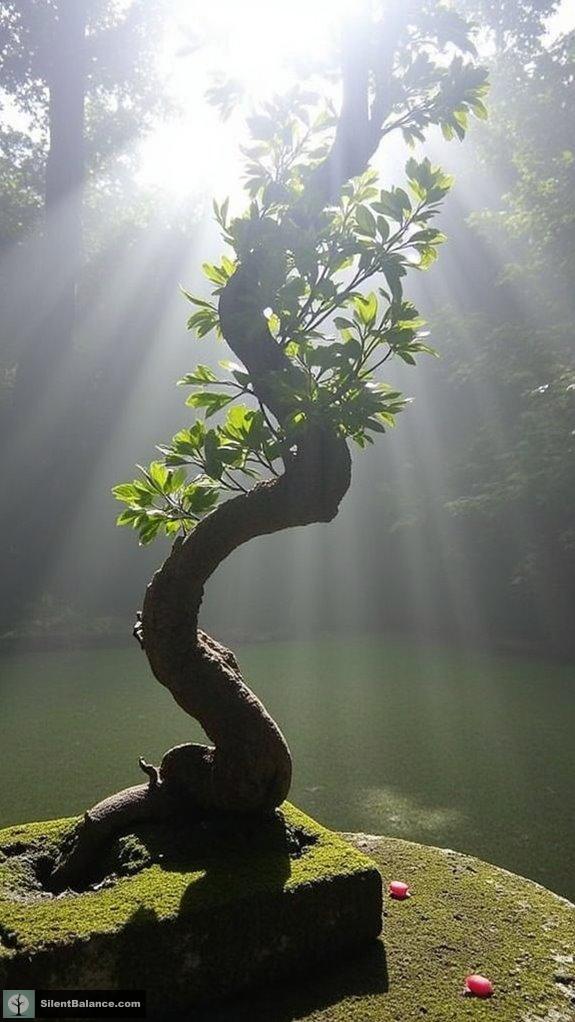
When I think about natural aesthetic harmony in bonsai styles, it’s hard not to get excited about the incredible ways these miniature trees reflect the beauty of their larger counterparts in nature.
Take the Informal Upright (Moyogi) style, for instance—its S-shaped trunk radiates movement, just begging for attention.
Or the Slanting style (Shakan), where a tree leans dramatically, embodying environmental factors against the forces of nature.
And let’s not forget the cascade style (Kengai), with branches that gracefully tumble, mimicking cliff-hanging growth.
These styles embrace the beauty of asymmetry, creating a visual balance that feels intrinsic to nature.
Isn’t it amazing how bonsai can capture such deep connections with the earth?
I can’t help but smile when I see these living masterpieces!
Robust Species for Outdoor Environments
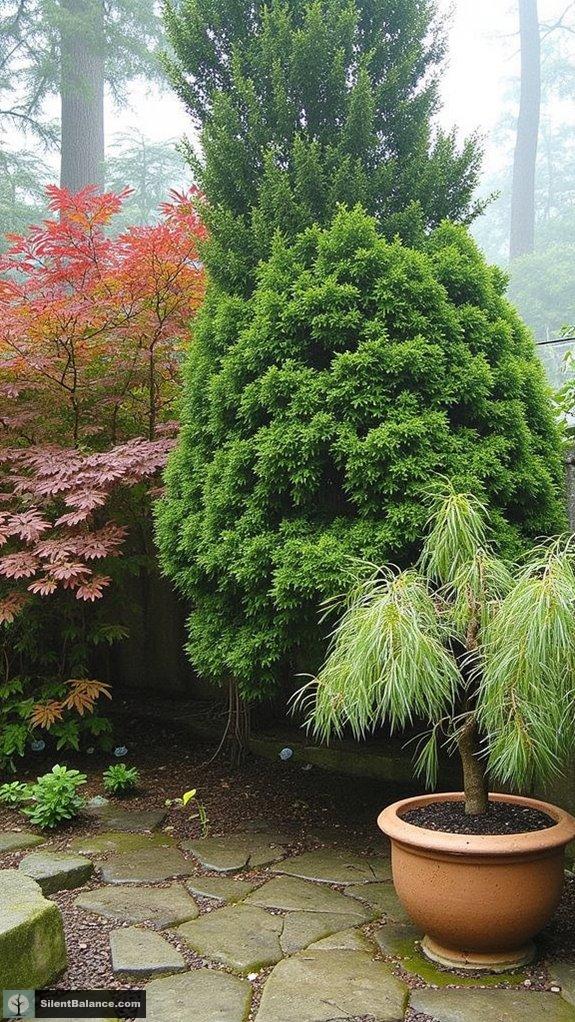
Choosing the right species for your outdoor bonsai is like picking the perfect partner; you want someone resilient, adaptable, and capable of thriving in various conditions.
Consider the Taxus, or yew—this beauty can brave temps down to -30°C! It’s a low-maintenance dream for those frosty winter nights. The black willow is another robust option, known for its ability to thrive in wet soils and tolerate flooding.
Then there’s the Oak, with its rough bark—that’s your sturdy friend who’ll quietly adapt to sunny spots and chill on the watering needs. Different species require varying levels of care, so it’s essential to understand what suits your environment.
Let’s not forget the Japanese Maple; though a tad high-maintenance, its vibrant leaves can steal the show!
With pines like Mugo and Japanese Black, you’re in for a treat—they grow effortlessly while keeping their elegant form.
Seasonal Changes and Visual Appeal
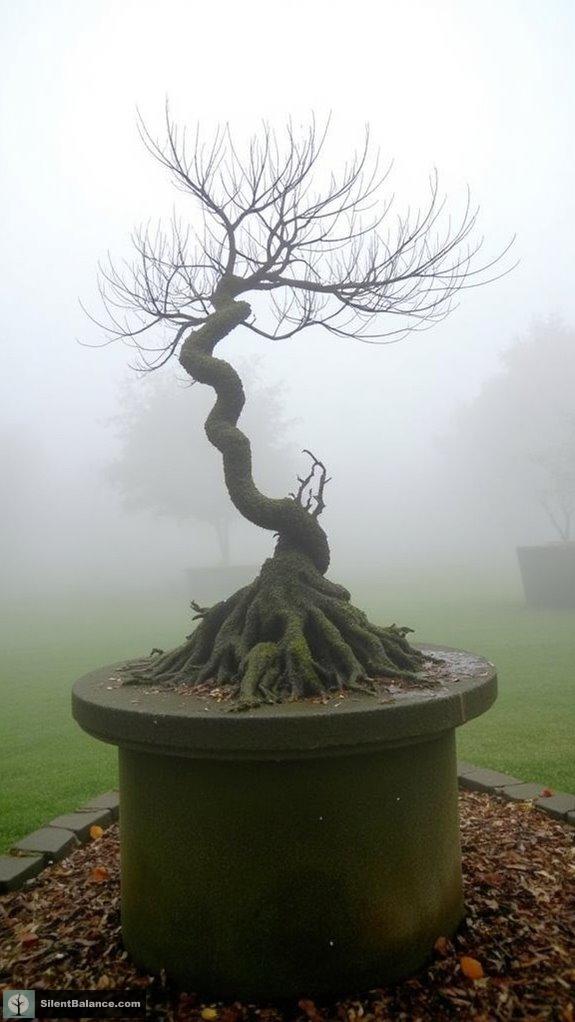
Outdoor bonsai does more than just survive seasonal changes; it actually thrives on them, giving us an artful canvas that evolves through the year.
Each season reveals a fresh chapter; spring’s vibrant greens burst forth, embodying renewal, while summer deepens those hues into lush, leafy pride.
When autumn arrives, it’s like nature throws a grand finale—reds, oranges, and yellows dance around, creating breathtaking contrasts.
And winter? Ah, that’s when the skeleton of the bonsai emerges, showcasing a beautifully sculpted silhouette, free from leaf distraction.
Isn’t it exciting how the tree morphs with each season? It’s a timeless performance, inviting us closer.
Seasonal changes aren’t just changes; they’re nature’s artful whispers, coaxing us to stop, look, and marvel. The potential for enlightenment within every individual mirrors the shifting beauty of bonsai, reminding us of our own personal growth through each season.
Practical Benefits of Bonsai in Outdoor Settings
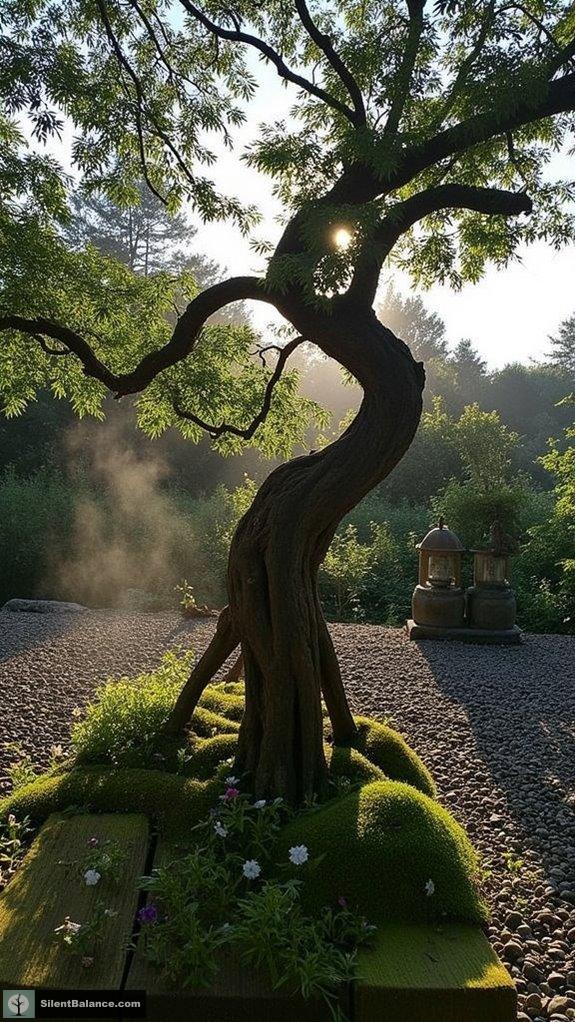
While tending to my outdoor bonsai, I often marvel at the myriad practical benefits these miniature marvels bring to my garden and beyond.
You know, that lush moss covering the soil isn’t just for looks; it helps retain moisture, cutting down on my watering chores. Plus, who wouldn’t love healthy roots that aren’t stressed by temperature extremes, right? Ground cover can be a lifesaver!
And let’s not forget the fresh air—it’s like having little filtration systems right outside my door! They help purify the air, making it better for both me and my nearby plants.
Honestly, engaging with these bonsai beauties offers a kind of low-impact exercise that could put a gym membership to shame.
Feel like a green-thumbed superhero yet?
Cultural and Artistic Significance in Landscaping
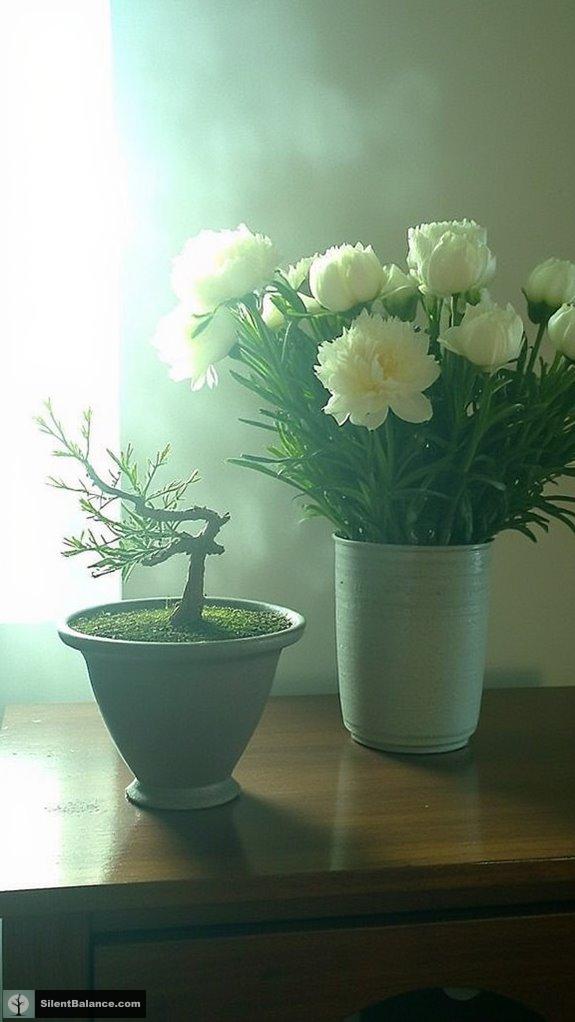
Bonsai isn’t just about having cool miniature trees; it’s a rich tapestry of cultural and artistic significance that adds depth to any environment.
Think about it—these miniature wonders carry histories stretching back over 2000 years, originating from ancient China and developing beautifully through Japan’s Zen influence. Isn’t that fascinating?
Each tree symbolizes harmony, balance, and the dance between nature and artistry. When you bring bonsai into your surroundings, you’re fundamentally inviting a piece of this vibrant heritage into your home.
Ever seen a bonsai in a family tokonoma? It’s not just decor; it’s an emotional connection, a conversation starter, and a storyteller.
Customization Options for Various Outdoor Themes
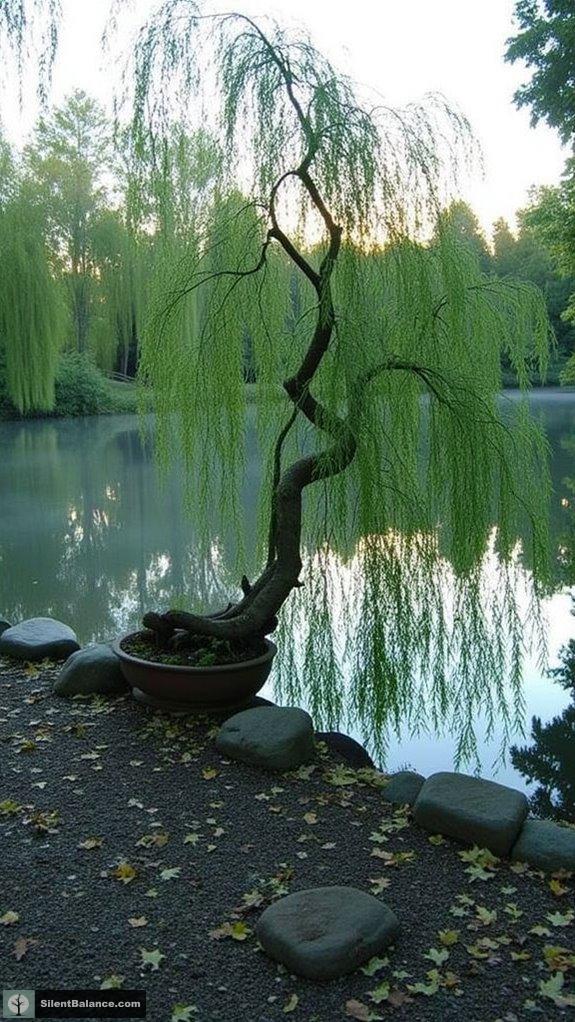
When it comes to customizing your bonsai for various outdoor themes, the possibilities are almost endless!
Envision this: a cascading bonsai next to a tranquil pond creates a picturesque scene. Or, think about the windswept style that echoes the breezy vibe of a coastal garden—how cool is that?
Formal gardens call for an upright style, neatly structured like a classic painting. If you’re leaning towards casual vibes, informal upright and broom styles blend beautifully with diverse plants.
Just keep in mind, it’s all about harmony!
Do you want your bonsai to shine as a focal point or mingle with other elements?
Whether minimalist or rugged, your bonsai can showcase your love for nature with a twist of personal flair! Isn’t that what it’s all about?
Integrating Bonsai With Other Garden Elements
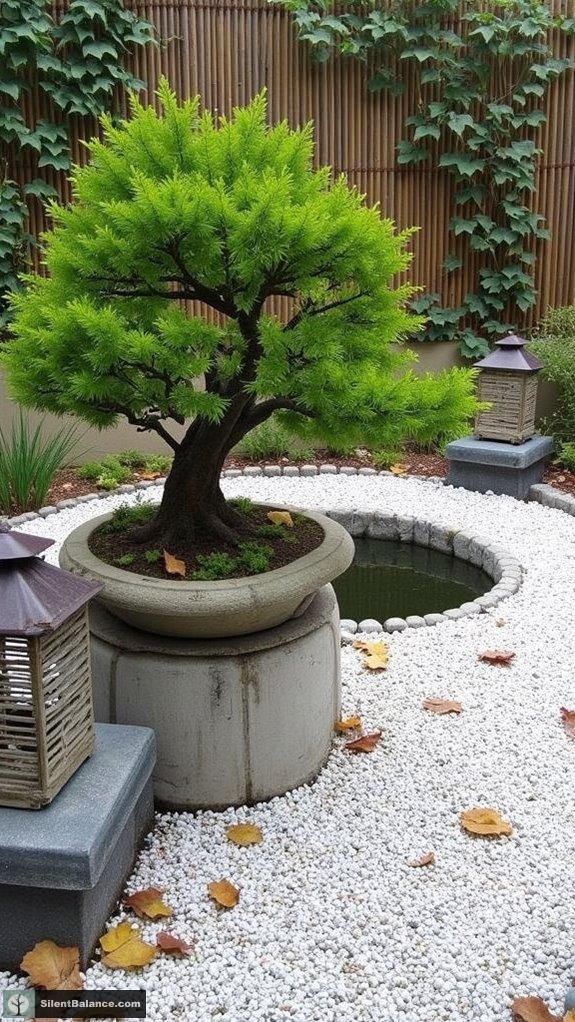
There’s something truly magical about how bonsai can complement other garden elements, don’t you think?
By integrating these miniature masterpieces with tranquil gravel paths and elegant stone lanterns, I find I create a hidden Zen oasis right in my backyard.
And let’s not forget about the calming effect of positioning bonsai near serene water features. The gentle ripples seem to accentuate their delicate beauty.
It’s essential, though, to strike that balance between free space and the filled areas; I like to think of it as giving each bonsai its moment to shine without looking cluttered.
Using bamboo panels or simple pebbles can really tie everything together, transforming the space into a meditative retreat that whispers relaxation and tranquility, don’t you agree?
Bonsai Tree Symbolism
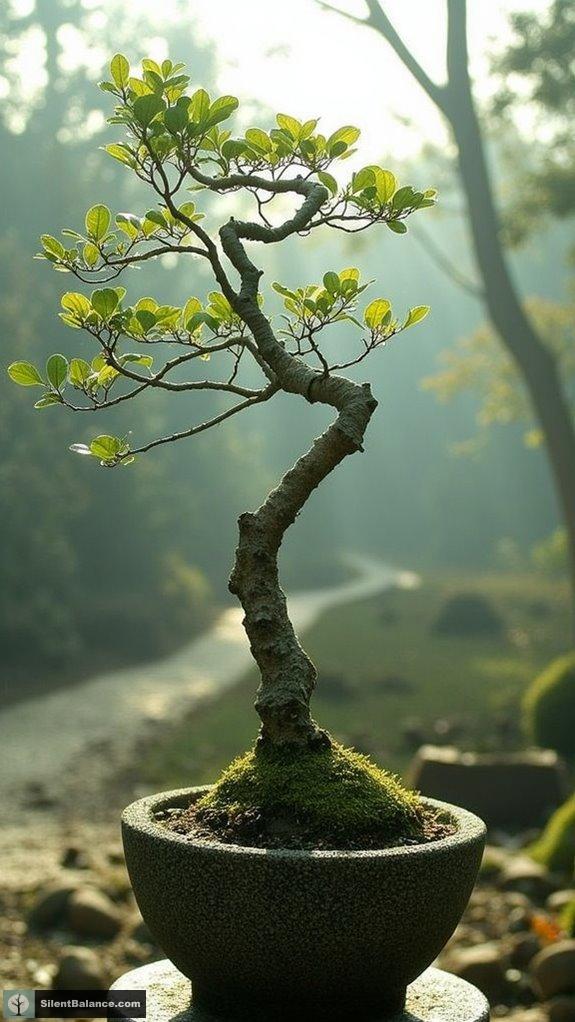
In the world of bonsai, every twist and curve tells a story, and that story is steeped in rich symbolism.
Bonsai trees symbolize harmony, peace, and balance—qualities we all crave in this hectic world, right? They require patience and meditation, resembling the careful nurturing we need in life.
Think about it: a tiny tree capturing the essence of nature itself! It’s no wonder bonsai’s linked to spirituality and Zen Buddhism.
Different species of bonsai, like the azalea, embody unique qualities—feminine beauty and love, for example. It’s like having a companion tree whispering life lessons in your ear!
Tree Symbolism
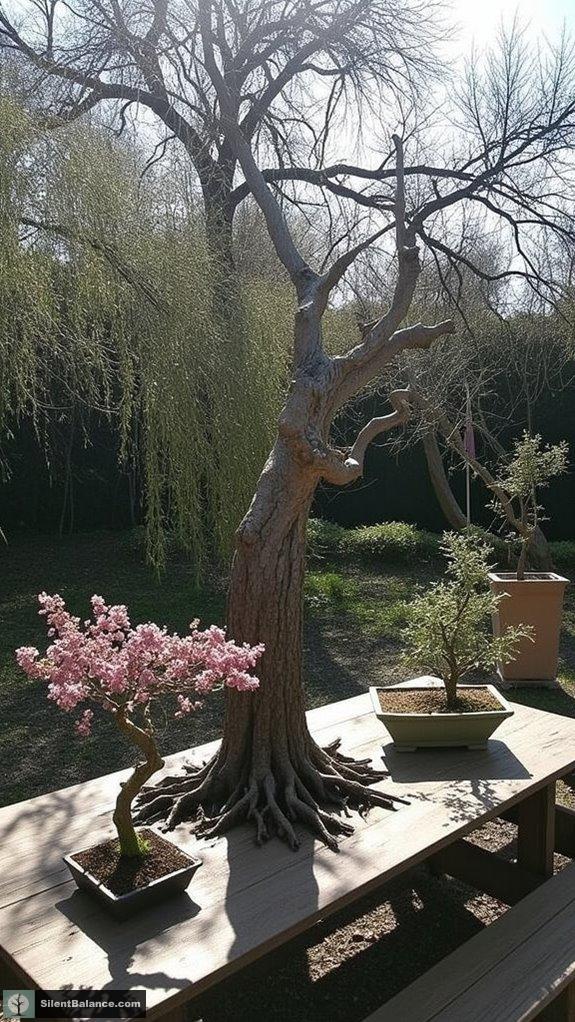
Bonsai enthusiasts often find themselves enchanted not just by the trees they cultivate, but also by the deep-rooted symbolism that trees embody in various cultures.
Take a look at how different trees convey unique messages:
| Tree Type | Symbolism | Meaning |
|---|---|---|
| Oak Tree | Strength, Stability | Protection during life’s storms |
| Cherry Blossom Tree | Love, New Beginnings | Romance and the beauty of life cycles |
| Olive Tree | Peace, Friendship | Harmony in relationships |
| Apple Tree | Knowledge, Growth | Continuous learning and opportunities |
Each tree tells a story, blending aesthetics with meaning. Choosing your outdoor bonsai decor isn’t just about looks; it’s about what resonates with you, isn’t it? What story do you want your bonsai to tell?
Questions and Answers
What Are the Best Containers for Outdoor Bonsai Trees?
When choosing containers for my outdoor bonsai, I prefer ceramic, unglazed pots. They provide aeration and drainage, helping roots thrive. Each aspect feels important, connecting me to nature and enhancing the beauty of my trees.
How Often Should I Water Outdoor Bonsai Trees?
I check my outdoor bonsai daily, especially during hot weather. I water when the soil feels slightly dry, ensuring it’s never bone dry or soggy. Observing their needs helps me keep them thriving and happy.
Can Bonsai Survive Winter Outdoors?
Bonsai in winter feels like a delicate dance; they can definitely survive outdoors with the right care. I’ve learned that protection methods, like mulching and proper shelter, work wonders for their winter health.
What Pests Should I Watch for With Outdoor Bonsai?
I’ve noticed aphids, mealybugs, and spider mites on my outdoor bonsai. I keep a close eye out for yellowing leaves and sticky residue. Regular checks and prompt treatment help keep my trees healthy and happy!
How Do I Fertilize Bonsai in Outdoor Settings?
Did you know that trees thrive on consistent nourishment, needing specific nutrients during active growth? I fertilize my outdoor bonsai with a balanced schedule, adjusting based on their needs to keep them healthy and flourishing.
References
- https://www.1800flowers.com/articles/flower-facts/types-of-bonsai-trees
- https://www.bonsaiempire.com/origin/bonsai-styles
- https://www.bonsainut.com/threads/style-list.40386/
- https://longwoodgardens.org/blog/2023-05-17/beauty-bonsai-styles
- https://forum.bonsaimirai.com/t/japanese-bonsai-garden-influence-for-landscaping-around-home/10589
- https://www.bonsaiempire.com/blog/kozumikku
- https://www.pinterest.com/ideas/bonsai-tree-zen-garden/953202706088/
- https://www.youtube.com/watch?v=7wmA0K2HoP8
- https://hookedonbonsai.com/your-guide-to-bonsai-tree-species/
- https://www.mistralbonsai.com/en/8-most-cold-resistant-bonsai/
- https://bonsai4me.com/species-guides/
- https://en.wikipedia.org/wiki/Bonsai
- https://easternleaf.com/bonsai-trees/bonsai-by-classification/
- https://miyagibonsai.co.uk/blog/bonsai-care/what-is-the-best-ground-cover-for-a-bonsai-tree/
- https://www.hortipower.com/blogs/news/ultimate-bonsai-plant-care-guide-expert-tips-and-benefits-of-grow-lights
- https://www.bonsaiempire.com/basics/general/calendar
- https://www.shopgardenrepublic.com/blogs/blog/8-most-popular-bonsai-trees
- https://www.backyardboss.net/bonsai-basics-caring-for-a-miniature-tree/
- https://www.shrubhub.com/blog/the-beauty-to-bonsai-garden-design.php
- https://www.chhajedgarden.com/blogs/all/benefits-of-bonsai-plants
- Unique Bonsai Pots for Zen Home Decor - September 6, 2025
- 7 Essential Tips for Selecting Outdoor Bonsai Tree Containers - September 6, 2025
- Perfect Pots for Thriving Tropical Bonsai Tree Containers - September 5, 2025

